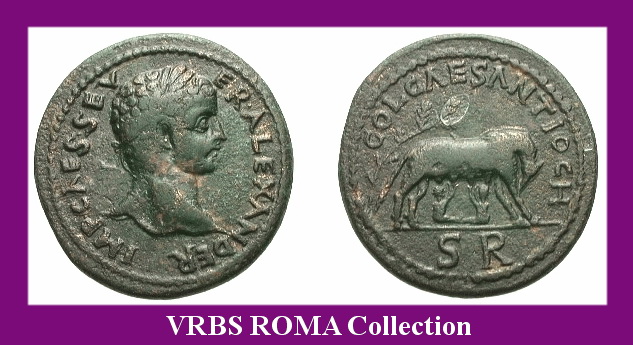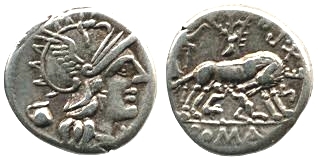|
|
|
The Story of Romulus and Remus
&
The Birth of Rome
First published April 19, 2010
at Hubpages.com
A study of the Roman Empire, its Emperors, and the coins they issued can
not be fully enjoyed without an understanding of the mythology and beliefs
surrounding Rome’s birth.
The City of Rome (VRBS ROMA Latin) is reputed to have been born when Romulus
killed his brother Remus on the fine spring day of April 21, 753 BC.
There is a lot to cover on this subject, and it is easy to get sidetracked
with related points, issues and possibilities, so I shall get right into
it. I won’t speculate on what might have been had Remus won that fateful
fight and killed his brother Romulus; such as the word ‘romance’ being
‘remance’, and The Eternal City of Rome being called The Eternal City
of Reme. I shall not even think about the mellifluous ‘Bella Roma’
being transmogrified into a cat-scratch cacophony of ‘Bella Rema’.
'All roads lead to Reme?' I shall try not to from this point forward.

VrbsRoma.com
(33mm 23.77grms)
Severus Alexander AE32 of Pisidia, Antioch
Obverse: IMP CAES SEVER ALEXANDER, laureate
head right
Reverse: COL CAES ANTIOCH, she-wolf and twins right,
SR in exergue
Lindgren 1222, BMC 64
(I purchased this coin from Harlan J. Berk, Ltd.)
This coin is the size of a silver dollar and about twice as thick. It is
made of bronze, and was issued by Severus Alexander. Caesar 221-222 AD,
Augustus 222-235 AD.
The Birth of Rome - (April 21, 753 B.C.)
The oldest evidence of humans living in what is now called Italy dates
from the Bronze Age of around 1500 BC. It wasn't until nearly 800 years
later, in 753 B.C., that a permanent 'Roman'settlement was begun. How that
settlement came to be, and who built and named it is at the heart of this
story; a story turned legend; turned myth.
Two closely related peoples lived in the area before the permanent settlement
was begun. They were the Latins and Sabines. Their story involves a she-wolf
saving twin baby boys, fighting and murder, heroes, villains, love, rape,
and hate. It is the story of the founding of ‘the eternal city’ of
Rome, and the beginning of the Roman culture.
The story of Romulus and Remus begins with a King named Numitor who was
overthrown and imprisoned by his brother. Numitor was the king of Alba
Longa. The brother that overthrew him was named Amulius.
Amulius was not only a mean and violent brother, he was a very frightened
and frightening king. When he saw that his brother's daughter, Rhea Silva,
might give birth to a boy child that might challenge his right to the thrown,
he sent her off to become a priestess with the Vestal Virgins.
He believed that making her become a virgin priestess would eliminate the
chance of an heir ever challenging him for the thrown. What he did not
expect was for a god to intervene. Mars, the god of war, visited Rhea Silva
and left her pregnant with twin boys. When these twins were born, Mars
returned, took them far away and cast them into the Tiber River. The river
water was high and turbulent as they drifted down stream. As it lowered,
the tired and hungry boys were washed ashore. Before they died, however,
a she-wolf, with the help of a woodpecker, found and began to care for
them. It shouldn't come as much of a surprise that the woodpecker and the
wolf are sacred to the god Mars.
Under a fig tree, the she-wolf warmed and nursed the twin baby boys back
to health.

(20mm 3.66grms)
Sex. Pompeius Fostlus. Silver Denarius, c.133-126
BC. Rome Mint
Obverse: Helmeted head of Roma rt., X below
chin and jug behind.
Reverse: SEX. POM. FOSTLVS, wolf rt. suckling
the Twins, shepard
on lt., birds on fig tree behind, ROMA in exergue.
RSC Pompeia 1
(Wikipedia Commons)
*********
This Roman Republic coin was issued by Sextus Pompeius. He was the paternal
uncle of triumvir Pompey the Great.
The boys grew big and strong under the care of the she-wolf and woodpecker.
Day followed day followed years while the she-wolf nursed and the woodpecker
stood sentry. Life moved along and life was safe. Then one calm and sunny
day while the boys and she-wolf were resting in the shade of the fig tree,
the woodpecker was alerted to a sound. They looked up to see a shepherd
named Faustulus, pushing through the leaves and branches. Faustulus was
taken by surprise when he saw the twins resting with a she-wolf. He had
merely wanted a better look at the woodpecker. However, finding the boys
in need of human care, he took them home to his wife Acca Larentia. Acca
Larentia, who was also known as Lobus (The Wolf), loved, nursed, and
|
|
Articles
By: Anthony Ballatore
Roman Emperors & their Coins
0)
Ancient Roman Coins On Ebay
1)
When, where & why were coins first made?
2)
The Story of Romulus and Remus & The Birth of Rome
3)
The Roman Republic
4)
Julius Caesar and the Death of the Republic
5)
Augustus Caesar: The First Roman Emperor
6)
Tiberius Caesar: The First Julio-Claudian Heir
7)
Caligula: The first really crazy Caesar
8) Claudius: A level headed Caesar?
9) Nero: The Last Julio-Claudian Heir
|
|
Websites worth knowing:
WildWinds.com
By far the single best location for identifying, evaluating, and touring
ancient coins. This link will direct you to their seach engines. Enjoy.
ForumAncientCoins.com
Along with WildWinds, this is a site of the highest regard, accurate
information, and ethical policies; 'AUTHENTICITY GUARANTEED FOR ETERNITY'
says it all.
FSRCoins.com
Frank S. Robinson is a unique individual. I have more respect for Mr.
Robinson than any other coin dealer. His book 'The Case for Rational
Optimism' (2009) will most likely leave you with this same perspective.
If his book doesn't, dealing with him will. He is often mistaken for Neil
Armstrong. :-)
Harlan
J. Berk, Ltd.
Located in Chicago, Harlan J. Berk, Ltd. is an excellent location for
both common and rare coins; often of
museum quality.
Rg.ancients.info
Reid Goldsborough's web pages are well written, educational, the first
site to read regarding counterfiet coins. This site is hosted for free
by VCoins.
VCoins.com
A commercial coin and information site established December 3, 1998.
Their code of ethics and years of operation speaks loudly.
DirtyOldCoins.com
Another commercial coin and information site.
ThePenAndQuill.com
One of our sites dedicated to pens, ink, quills, books, writing, reading,
history, and anything else that envolves language, art, and ideas.
|
raised the twins until they become strong young men.
As
the brothers grew, their adventures grew along with them. With each new
adventure, they would wander farther and staying away longer. Knowing that
the twins would eventually leave and not return, Larentia took the time
she had left to tell the twins of their past. When the boys learned of
their grandfather's imprisonment by his brother Amulius, they set out for
revenge. How could a brother do such a thing to another brother? This was
a matter they had to attend to immediately.
They
returned to Alba Longa and set their grandfather free and murdered his
brother Amulius. With that done, they returned to the place near the Tiber
River where their father, Mars, had placed them under the care of the she-wolf
and woodpecker. The surveyed the land near and around the fig tree. They
noticed seven hills. Romulus built a camp on Palatine Hill. Remus built
camp at Quirinal Hill. Palatine and Quirinal Hill are two of the Seven
Hills of Rome.
One
day Romulus began building a wall around his camp. With the wall built,
Romulus invited all murders, thieves, slaves, and outcasts to his camp.
He offered them safety behind his walls.
Remus
noticed the attention Romulus was getting with his wall and became jealous
and insecure. He started to criticize his brother and the wall. The wall
was not very high, and at one point Remus said he would show his brother
how sad a wall he had to offer, and jumped over it laughing. Romulus became
so furious that he attacked and killed Remus. Then, to further demonstrate
how personal his village was to him, he named it after himself. The village
of Romulus was named Roma (Rome).
It
wasn't long before Romulus noticed that the slaves, thieves, murderers,
and outcasts that populated Rome were primarily men. He remembered how
a great deal of the Sabines, who occupied the camp Remus had built on Quirinal
Hill, were women. Romulus organized his men, announced a huge party, and
invited the entire Sabine camp. When they were all drunk and sleeping,
he and his men stole a large number of the Sabine women. This upset the
Sabine men very much. However, as time pasted, the Sabine women found husbands
and started families. Their families back at the Sabine village convinced
the Sabine men that they were safe, well provided for, and not in danger.
They begged the Sabines to forgive Romulus and his men and make peace.
From that time on, the two hills joined to make a bigger and stronger Rome.
The
great city of Rome that exists today had begun its march through time.
|
|
|